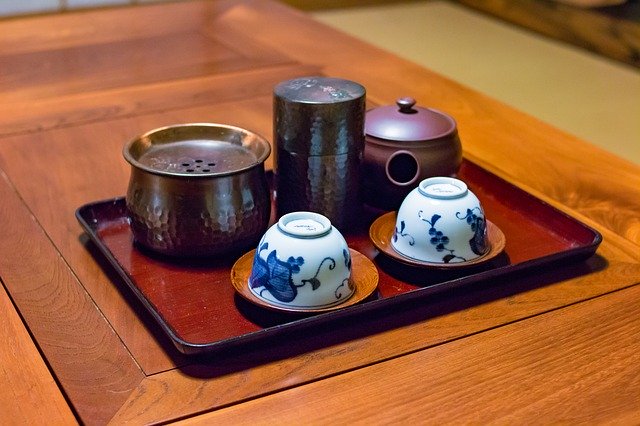Tea is the most common and important drink in Japan, and as you can imagine, there are a few things you should know about how to talk about the many types of tea in Japan.
The basic word for tea is ocha (お茶, おちゃ). If you ask for it without specifying anything further, you’ll get green tea, specifically sencha (see below). Green tea is made from the same Camellia sinensis leaves as other kinds of tea, but with green tea, the leaves aren’t allowed to oxidize. In black teas, a long period of oxidation gives the leaves their dark color and their bold flavor. In green teas, the leaves are dried, either in a pan or in an oven, and this drying prevents oxidation, so the leaves stay green and have more of a leafy, grassy taste.
Green Tea
Sencha (煎茶, せんちゃ) is “basic” green tea, the most common of the types of tea in Japan. Over three quarters of the tea produced in Japan is sencha. After the leaves are picked, they’re steamed for about twenty seconds, which prevents oxidation. Then the leaves are rolled, and this gives sencha leaves their shape.
Genmaicha (玄米茶, げんまいちゃ) is sencha combined with puffs of roasted brown rice. When it’s steeped, it has a yellow color, and the roasted rice gives it a nutty taste.
Houjicha (ほうじ茶, ほうじちゃ) is like sencha, but instead of being steamed, the leaves are roasted in a porcelain pot over charcoal. The higher temperatures turn the leaves reddish-brown, and instead of the grassy flavor of sencha, houjicha has a deeper, caramel flavor and less caffeine.
Bancha (番茶, ばんちゃ) is similar to sencha, but the leaves are harvested later, so it’s considered a lower quality and is therefore less expensive.
Matcha (抹茶, まっちゃ) is the green tea powder that’s used in the traditional Japanese tea ceremony. Before the leaves are harvested, they’re grown in shade for about a month, which produces more caffeine and theanine. To prepare matcha, the tea powder is mixed with near-boiling water using a chasen ( 茶筅, ちゃせん), a bamboo whisk.
Gyokuro (玉 露, ぎょくろ) is considered to be the finest kind of green tea. The plants are kept in the shade before being harvested, protected from the sun for at least twenty days. This gives the tea a sweeter taste.
Black Tea and Other Drinks
There are other types of tea in Japan that aren’t green tea. If you specifically want black tea, it’s called koucha (紅茶, こうちゃ). Kou (紅, こう) actually means deep red or crimson, rather than black. There are many kinds of black tea – Assam, Darjeeling, Ceylon, and so on – and this is what you’re probably most familiar with if you’re a tea drinker in the west.
Uuroncha (烏龍茶, ウーロンちゃ) is oolong tea. You may think of oolong as another kind of black tea, but it’s actually between green and black tea when it comes to oxidation. Tea leaves for oolong are allowed to dry and wither in the sun and are semi-oxidized. There are a lot of varieties of oolong, mostly from China.
Mugicha (麦茶, むぎちゃ) is not actually tea, but is instead an infusion of roasted barley. It’s caffeine-free and has a toasted nutty flavor. It’s commonly drunk cold in Japan as a summer refreshment, but you can also drink it hot.
Konbucha (昆布 茶 , こんぶちゃ) in Japan is not the same thing as the fermented, fizzy, vinegar-esque (and some say very stinky) kombucha that’s become popular in the US. That kombucha is made from a kind of mushroom. Japanese konbucha is made with 昆布, こんぶ konbu (kelp), a very common seaweed. You could be welcomed to a traditional ryokan (旅館, りょかん) with a nice cup of konbucha. You don’t have to go to Japan to taste all of these varieties of tea. They’re easy to find in tea shops or even supermarkets in the West, or of course online. They’re all different, but they’re all oishii (おいしい), delicious.
Learn Japanese with the Language Garage
Check out our other posts on Japanese language, culture, and more. And if you’re looking for convenient and affordable live Italian lessons with a real teacher, check out The Language Garage. Our lessons are given online in a virtual classroom, so it doesn’t matter where you live or work – we can come to you. And we have flexible options, with a free trial so that you can decide if there’s a fit. Check us out!





